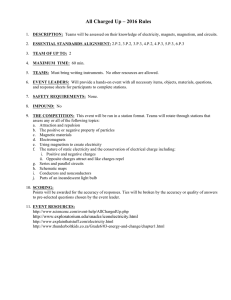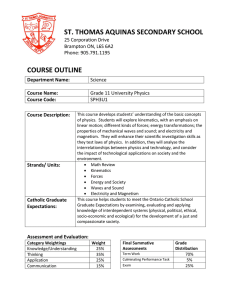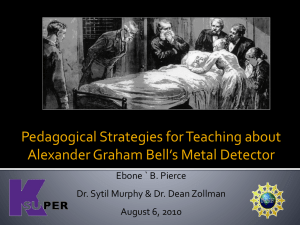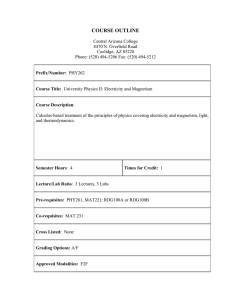FOSS® at HOme - Birmingham Public Schools
advertisement
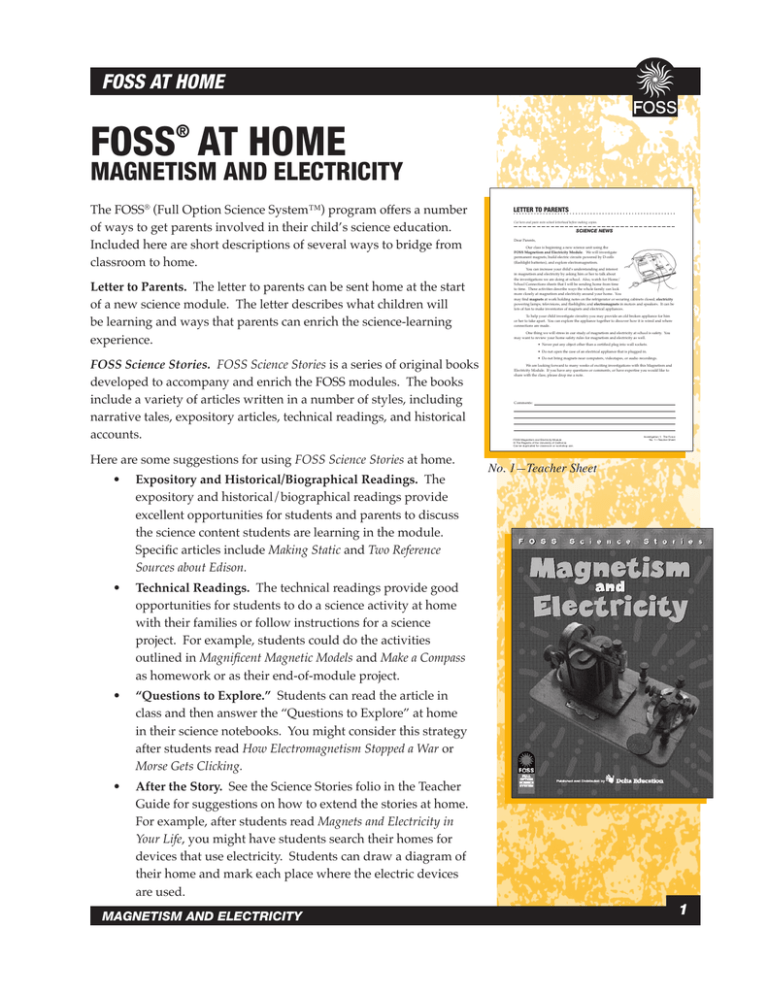
FOSS at Home FOSS® at Home MAGNETISM AND ELECTRICITY Name ____________________________________ The FOSS® (Full Option Science System™) program offers a number of ways to get parents involved in their child’s science education. Included here are short descriptions of several ways to bridge from classroom to home. Letter to Parents. The letter to parents can be sent home at the start of a new science module. The letter describes what children will be learning and ways that parents can enrich the science-learning experience. FOSS Science Stories. FOSS Science Stories is a series of original books developed to accompany and enrich the FOSS modules. The books include a variety of articles written in a number of styles, including narrative tales, expository articles, technical readings, and historical accounts. Here are some suggestions for using FOSS Science Stories at home. • Expository and Historical/Biographical Readings. The expository and historical/biographical readings provide excellent opportunities for students and parents to discuss the science content students are learning in the module. Specific articles include Making Static and Two Reference Sources about Edison. Date LETTER TO PARENTS ___________________________________ Cut here and paste onto school letterhead before making copies. SCIENCE NEWS Dear Parents, Our class is beginning a new science unit using the FOSS Magnetism and Electricity Module. We will investigate permanent magnets, build electric circuits powered by D-cells (flashlight batteries), and explore electromagnetism. You can increase your child’s understanding and interest in magnetism and electricity by asking him or her to talk about the investigations we are doing at school. Also, watch for Home/ School Connections sheets that I will be sending home from time to time. These activities describe ways the whole family can look more closely at magnetism and electricity around your home. You may find magnets at work holding notes on the refrigerator or securing cabinets closed; electricity powering lamps, televisions, and flashlights; and electromagnets in motors and speakers. It can be lots of fun to make inventories of magnets and electrical appliances. To help your child investigate circuitry you may provide an old broken appliance for him or her to take apart. You can explore the appliance together to discover how it is wired and where connections are made. One thing we will stress in our study of magnetism and electricity at school is safety. You may want to review your home safety rules for magnetism and electricity as well. • Never put any object other than a certified plug into wall sockets. • Do not open the case of an electrical appliance that is plugged in. • Do not bring magnets near computers, videotapes, or audio recordings. We are looking forward to many weeks of exciting investigations with this Magnetism and Electricity Module. If you have any questions or comments, or have expertise you would like to share with the class, please drop me a note. Comments: FOSS Magnetism and Electricity Module © The Regents of the University of California Can be duplicated for classroom or workshop use. Investigation 1: The Force No. 1—Teacher Sheet No. 1—Teacher Sheet • Technical Readings. The technical readings provide good opportunities for students to do a science activity at home with their families or follow instructions for a science project. For example, students could do the activities outlined in Magnificent Magnetic Models and Make a Compass as homework or as their end-of-module project. • “Questions to Explore.” Students can read the article in class and then answer the “Questions to Explore” at home in their science notebooks. You might consider this strategy after students read How Electromagnetism Stopped a War or Morse Gets Clicking. • After the Story. See the Science Stories folio in the Teacher Guide for suggestions on how to extend the stories at home. For example, after students read Magnets and Electricity in Your Life, you might have students search their homes for devices that use electricity. Students can draw a diagram of their home and mark each place where the electric devices are used. Magnetism and Electricity Magnetism and electricity Name ____________________________________ Date ___________________________________ HOME/SCHOOL CONNECTION INVESTIGATION 2: MAKING CONNECTIONS WHERE’S THE ELECTRICITY? Where’s the electricity in your home? Take a tour and count the number of: • Lights. ________________________________________________________________________ _________________________________________________________________________________ • Appliances that use electricity. ___________________________________________________ _________________________________________________________________________________ • Wall outlets where you can plug things in. _________________________________________ _________________________________________________________________________________ • Wall switches for turning on lights. _______________________________________________ _________________________________________________________________________________ Be sure to talk with your family about safety when using electric appliances. Write your family safety rules below. Home/School Connection No. 35—Student Sheet FOSS Magnetism and Electricity Module © The Regents of the University of California Can be duplicated for classroom or workshop use. No. 35—Student Sheet Name ____________________________________ Date _____________________________________ MATH EXTENSION—PROBLEM OF THE WEEK INVESTIGATION 1: THE FORCE BUYING MAGNETS A teacher wants to set up a Magnet Exploration Center where students can find out more about magnets during their free time. She has $50.00 to spend. She looked in the magnet section of a science catalog and found these prices. ITEM QUANTITY PRICE Large bar magnets Set of 2 $10.95 Small bar magnets Each $2.75 Large horseshoe magnets Each $7.95 Small horseshoe magnets Each $4.50 Disk magnets Set of 4 $4.50 Lodestones Set of 10 $7.95 Student Sheets. Throughout the module, students complete various recording and response sheets. Students should bring the sheets and/ or their science notebooks home for families to review and discuss. For example, student sheet number 7, The Flow of Electricity, is a good opportunity for students to explain and review with parents how electricity flows. Home/School Connections. Home/School Connections are activities developed specifically for the whole family to enjoy at home. For example, in Investigation 2 (student sheet number 35) students create an inventory of electric fixtures and appliances around their home and then develop a list of rules for using electricity safely. Interdisciplinary Extensions. Each investigation has suggestions for art, language, math, social studies, and science extensions. These are good family activities. For example, after Investigation 5 students can build a cardboard telegraph at home. They might also do the Math Problem of the Week at home. FOSSweb (www.fossweb.com). FOSSweb is an interactive website where families can find instructional activities and interactive simulations specifically designed for each FOSS module. 1. What materials would you recommend she buy for the Magnet Exploration Center? (Remember, she has only $50.00 to spend.) 2. Write a paragraph about why you chose the items you did. FOSS Magnetism and Electricity Module © 1998 The Regents of the University of California Can be duplicated for classroom or workshop use. Problem of the Week No. 29—Student Sheet No. 29—Student Sheet NOTE: All student sheets, including the Letter to Parents, Home/School Connection, and Math Problems of the Week, are available in FOSS Teacher Guides and online at www.fossweb.com. They are also available in Spanish. See For Parents and Teachers: Home/ School Connection on page 4 of this folio. NOTE: Pages 3 and 4 of this folio can be photocopied and sent home for parents to read. These pages provide information on the resources for students and their families on FOSSweb. full option science system FOSS at Home FOSSWEB (WWW.FOSSWEB.COM) The FOSS program maintains a resource-rich website for students and their families and friends. To explore the resources available for the Magnetism and Electricity Module, first enter www.fossweb.com in your browser. The FOSS website requires plug-ins for your browser. We recommend that you click the “Test Your Browser” link at the bottom of the home page before you begin to ensure your computer has the minimum requirements. Click the grades 3–6 icon to get a menu that links to each of the 3–6 modules. There you can choose Magnetism and Electricity and travel to a wealth of information and activities specific to this module. ACTIVITIES In the Magnetism and Electricity Module, you’ll find two activities: Kitchen Magnets and Electromagnet. Kitchen Magnets should be introduced after students have completed Investigation 1: The Force. This activity challenges children to find different magnets in a typical kitchen. You might ask, • What are some different uses of magnets? • Where are magnets used in your kitchen? Magnet locations are highlighted as the cursor is moved around the kitchen. When you click on a magnet, information about it appears. Children can keep a record of where they find magnets in the kitchen, and then look for similar magnets in their own kitchen. The Electromagnet activity should be introduced after students have completed Investigation 4: Current Attractions. In this activity, children will change different parts of an electromagnet and observe the results. You might ask, • How did you make an electromagnet? • How did you change the electromagnet to increase the number of washers you could pick up? Point out the different parts of the electromagnet that can change in the activity: the wire gauge, the type of wire, the type of current (power supply), the voltage, and the number of winds. Explain that AC means alternating current, and DC means direct current. Try Magnetism and Electricity Magnetism and electricity different combinations of these parts to find out which combination picks up the most iron filings. Set up one combination of parts and test it. Point out that the number of iron filings changes each time one of the parts is changed. MOVIES The Movies section includes animations of how some electric devices operate. The electric devices include a speaker and a lightbulb. PICTURES In the Pictures section, you can view images of several electronic devices that have been dissected and places where electricity is generated, such as Hoover Dam. WEBSITES The Websites section includes links to sites that can extend and enrich children’s experiences with the Magnetism and Electricity Module. VOCABULARY In the Vocabulary section, you will find the glossary words and definitions used in the Magnetism and Electricity Module. They are provided in English and Spanish. BOOKS/SOFTWARE This section includes an annotated list of books, videos, and software recommended for the Magnetism and Electricity Module. You should be able to find many of these titles at your local library. For parents and teachers: Home/school connection The For Parents and Teachers section includes the Home/ School Connection that describes ways for families to do science together. For example, in Investigation 1, families search for permanent magnets in their home and later design a magnet game. Look in this section for other resources included in a downloadable PDF file, including a general letter introducing the module, student projects, and math problems that relate to the science investigations. Copyright The Regents of the University of California full option science system 1014229
